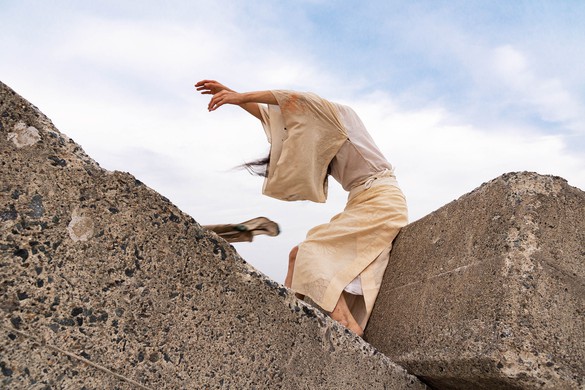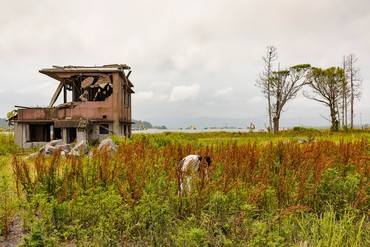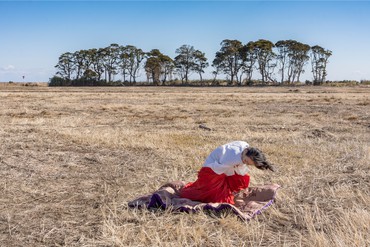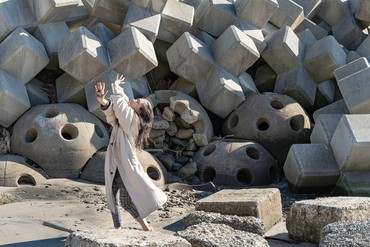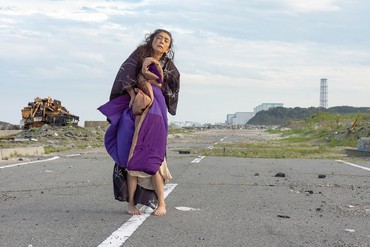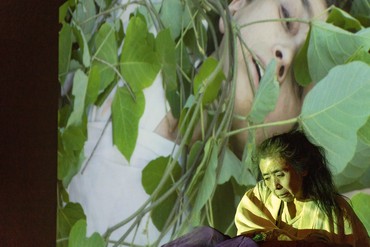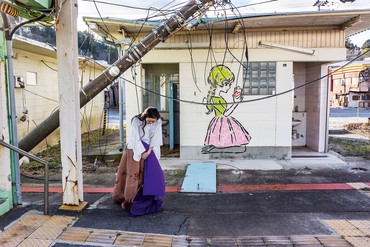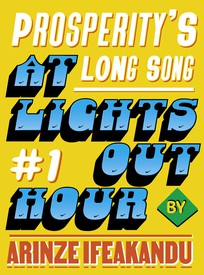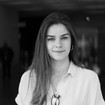
Gillian Jakab is an editor, online and print, of Gagosian Quarterly and has served as the dance editor of the Brooklyn Rail since 2016.
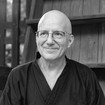
William Johnston grew up in Rawlins, Wyoming. He received his BA from Elmira College, New York, his MA and PhD from Harvard University, and studied at Nanzan University and the University of Nagoya, Japan. He is the John E. Andrus Professor of History at Wesleyan University and the author of two monographs and numerous essays. Photo: Andrew Pekarik
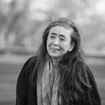
Born and raised in Japan, Eiko Otake is a New York–based, interdisciplinary performer and choreographer. After working for more than forty years in the partnership Eiko & Koma, she now works as a soloist and directs her own collaborative projects. Photo: Tatsuhiko Nakagawa
Eiko Otake has worked for decades as part of the performance duo Eiko & Koma; her ongoing project A Body in Places marks her first solo endeavor. Published ten years after Fukushima’s earthquake, tsunami, and nuclear meltdown of 2011, the book documents six years of Otake’s and Johnston’s visits to the irradiated landscape. Here they discuss the relationships between performance and photography, history and the body, witnessing and conveying.
Gillian JakabThe two of you first worked together in a classroom: you cotaught a course on the history and artistic interpretations of Japan and the atom bomb at Wesleyan University. How did your partnership begin?
William JohnstonWell, Eiko, how was it that you and Sam [Miller] got together and decided you should be teaching courses? Because that’s the real inception of this.
Eiko OtakeSam was a good friend of mine. We met when he was director of Jacob’s Pillow, and in 1998 he asked me to be an adviser to the National Dance Project, the presenters’ network he created some time ago. I was frustrated to be only advising, not voting or fully discussing as equals with the rest of the group. I wanted to do something more in a setting like this.
After 9/11, I was so shaken; my calm, which I don’t have much of, was totally taken away. I spoke with honesty among our artist friends, and with Sam, and out of these conversations Sam created the Center for Creative Research, which we called CCR. Eleven choreographers, none of us young. We got funding to explore how this particular group of artists could converse within institutions of higher education, and nurture sustainable relationships with them, for their mutual benefit.
From there I made my way to Wesleyan, where my sons were students, and met Bill early on. He knew I was working on my master’s thesis on atomic-bomb literature and he asked, “Want to coteach?” And I went, “Oh, could I?” [laughs].
WJIt was actually even funnier on my side. I was invited by the director of Wesleyan’s Center for the Arts, Pam Tatge, now at Jacob’s Pillow, to work with a group of visiting artists and see if they would want to integrate performing arts with courses on history and science, et cetera. Then Eiko came in and I was like, “Wait a minute, you’re Eiko & Koma Eiko” [laughs]. I’d been a fan of their work, and I knew a photographer who had shot them before, so we really hit it off.
How do you go from a nuclear wound inflicted by the Other to a self-inflicted nuclear wound? We’ve got a way of exploring this through Eiko performing in these places.
William Johnston
GJIt was meant to be! So your shared interest in the subject matter of the class led to your collaboration on A Body in Fukushima?
EOYes, I would credit our teaching. I knew Bill was interested in matters of massive violence, energy, public health, and radiation, which we were able to explore together in different forms.
WJWe had these background intellectual goals, as you’ve noted, coming out of the atomic-bomb project. And behind all of this, there’s this larger question: how is it that Japan, which became the first country and only country to experience nuclear bombing in war, also then managed to become the site of the world’s second-worst nuclear meltdown? How do you go from a nuclear wound inflicted by the Other to a self-inflicted nuclear wound?
We’ve got a way of exploring this through Eiko performing in these places. At least for me, as we were working, I came to realize that the performance isn’t really something I’m photographing; rather, I’m trying to create photographs that create a performance for the viewer. In a sense, looking at the photographs is a manifestation of a performance itself.
When I’m shooting with Eiko, my inclination toward large-format photography is always with me. I’m seeing a landscape and I ask, How do I place Eiko in this landscape? How are they in a dialogue with each other, as well as with me, at the same time?
GJWhat made you decide to go to Fukushima in 2014?
EOWell, I didn’t all of a sudden come up with the idea of, Let’s go. I was there in August of 2011. I’m the kind of person who does not shy away from visiting the site of a historical event, of massive wrongdoings. If I’m in Poland, I go to see Auschwitz, for example. Since a long, long time ago, performers have functioned as sort of community connectors. People live in their communities, and we performers travel, see, hear things, and sometimes get intimate knowledge by being somewhere. So when my old friend was available to take me to Fukushima, I knew it would be a very strong experience.
But I had to be a little bit dormant on this, because in 2011 we were doing an Eiko & Koma retrospective project. We were extremely busy looking back at everything Eiko & Koma had done—presenting the history, editing Eiko & Koma’s book published by the Walker Art Center—and creating a new work. It was only after 2013, after Eiko & Koma’s engagement at the Museum of Modern Art in New York, that I could begin to ask, Now what? What’s next?
Eiko & Koma had been invited by the Pennsylvania Academy of the Fine Arts to perform in Philadelphia’s 30th Street Station and I decided to do this alone. I wanted to do something that wasn’t with Koma. Being in the busy and grand Philadelphia station somehow made me think of desolate Fukushima stations—they were almost opposite places, which makes me see the particulars of both. When I decided to go, my first plan, which didn’t last very long, was to take photographs of myself in very deserted stations I remembered from the 2011 visit. But once we were there, there was absolutely no reason to limit ourselves to stations, so, we decided to forego that plan.
WJI’d say, “Eiko, here’s a road. I don’t know where it goes, but I can tell what direction we’re heading and about what to expect.”
EO I’m a horrible navigator [laughs]. Bill, who can read Japanese, is better than I am at reading the signs on the road.
WJ That’s how we ended up at this one place called Yabure-machi, which is the image where Eiko is sort of red around her lower body, white on top, and she’s crouched down in the field with her head bent over. It was at that point we realized, “Oh, this is a body in places, this is much larger than stations. We’ve got to just keep exploring more places.”
GJHow could you sense when a place felt right?
WJWe got there, and both of us spent probably fifteen, twenty minutes, a half hour, walking around separately, just looking. I remember I was just in tears, looking at these houses—what people had, their living effects, the insides of their houses, were as they were right after the tsunami, it had never been cleaned up, it was all radioactive. I’m going, “My god, these people, they couldn’t come back and even take care of their places.” Eiko and I then saw each other again and she was in the same condition, very much in tears. “My god, what do we do here?” we asked each other. That’s where it really took off. It was a very real physical sensation for both of us.
EOYes, and for safety reasons, we were limited in the areas we could go. You can visit these areas but can’t stay overnight. People commute to work there. I remember this body feeling: the minute we got into this area where people can’t stay, my whole body tensed.
In this trip, looking at the brokenness all around, I learned that many things imitate the human body. For example, the seawall built to protect from tsunamis: when the seawall looks complete, it looks very alien, but when it’s broken, inside it looks like an intestine. I started to feel the skin. I started to feel its core, like a backbone. I started to see the body as a metaphor or perhaps as unintended inspiration. Maybe because I’m a body-worker. Maybe because people who make the wall are unconsciously imitating human bodies, as those are what we live with.
GJFrom your first visit to Fukushima together, in January 2014, to your most recent visit, in December 2019, what felt different? How did your experience with the region evolve and how did that play out in the performance project?
WJAs time went on, I think we got a lot looser in terms of where we would go. We would take a road not knowing where it would lead or come across a little shrine and decide to check it out. I think both of us really had a sense of how things were changing in Fukushima. In particular, in that first place we went to, Yabure-machi, we explored this old house that had these two chairs sitting together. The next time we got there, in 2016, it was gone. Buried. It seemed to have been dismantled like the surrounding houses that had just disappeared without a trace, and the vacant lot where it had stood was then used to store dirt from other places. A lot of places were like that, so it had this very visceral effect on both of us. By 2019, everything was changed for us. The coastline had become this huge concrete thing, which is as much political as anything. Eiko’s approach to performing there also changed. Her costume went from being, “Gee, which kimono do I wear,” to all of a sudden she found herself performing in street clothes.
GJThe materials Eiko wears or holds are stunning parts of the performance photographs. I’d love to hear more about them.
EOWhen I was there in 2011, it was much stricter: you couldn’t go within twenty kilometers of the radiation site. But outside of that, I saw all the things the tsunami had scattered, irradiated piles of what looked like blankets, futons, comforters. And in places like Fukushima, futons often have kimono colors, because often people use old kimonos to make the surface. A tsunami covers everything with dirt, but I could still see those colors, and I could resonate with those colors—they were the colors I’d grown up with.
So when I returned to Fukushima in 2014, I packed my grandmother’s kimono. I have this policy: I never hire a costume designer or buy a new costume. Instead, I tend to seek some sense of personal relationship with props or costumes. In Fukushima, when we found a site, I would then think about which color to wear or carry with me. And that became part of the choreography for me, too, once I was committed to being there.
GJHow does the choreography come about? You’re used to collaborating on movement as part of Eiko & Koma. For this project, what was it like to collaborate, not in creating the movement, but in its documentation?
EOWith Eiko & Koma, we don’t always have to do the exact same thing, but we do have choreography in relation to one another. For a solo performer, there’s no inconvenience to improvise; I don’t have to worry about meeting Koma at a certain point in a certain area. So I can focus on motivating myself. In Fukushima I was sensing the wind, history, and bleakness of our future.
Once Bill starts to shoot, all I care about is a possibility that he can pick some moment—that mindful eye is all I need. The movement itself just happens. Either I’m moving my body or my body is sensing other movements in the world. Bill’s being, his eyes, his point of view with the camera—these made me able to reach what I call “movement and dance at the same time.” What happens is, I’m at the intersections of many different movements, drawing from history, social dynamics, wind, waves—many of the parts of Fukushima that we visited are by the ocean, so you always hear the ocean waves growing louder or quieter. All those natural shifts, the changes of seasons, are movement. And trucks and workmen’s machine noises change the landscape. For the performance, once I choose the color of the costume, the rest really is: how do I be a part of this, my surroundings? I’m now saying to myself and to others, Going to a place is a choreography. Being in that place determines a lot of things. I think that’s a discovery that came out of this project.
GJIt’s quite a feat to communicate the visceral experience of being in a place with audiences far away. You’ve done this over the years in many forms: exhibitions, video installations, film screenings, and now your forthcoming book. How does the book form provide another way of engaging with and sharing the project?
EOYes, I made a commitment to the Fukushima project: I would bring it everywhere I go. After every visit there, Bill and I would work together to create a video or have a photo exhibition. How we do it and what it looks like, each community has to decide. It gave us both the opportunity to work with curators, learn how to create exhibitions, and then how to present my body in those exhibitions.
WJAnd then the book project itself was something people had said to us, “You really need to make a book of these photographs.” Once we started talking about it more seriously, WesPress felt like the right fit: they do excellent photography work, they were historically a fairly major player in photography, and they’ve remained a major player in dance publications.
We went back and forth with the idea of inviting various authors. Eiko had been working with a curator who said, “Look, you’re working with a historian. Use him.” So that’s what we decided to do for some of the writing in the book. What I’ve written there does very much come out of my historical background. I come from the field of the history of disease and epidemics. As a result, I think in terms of multifactorial causation all the time, to use the epidemiological term, which is quite simply to say, a causal agent—a virus, bacillus, toxin, whatever—doesn’t instantly cause disease in the body; it’s many things coming together.
A big example right now: some people are exposed to the covid virus, nothing happens. Other people with the same exposure, bam, they’re down. And why? Well, it’s all of these different factors coming together at the same time. And that’s always been my thinking about epidemics, but it also works for something like a big nuclear meltdown. What were the different historical, social, political, and cultural elements that came together to create this huge meltdown in Fukushima and the way it’s been handled ever since? There’s no single narrative as a result. The way we understand the world around us is not a single narrative, it’s always multiples, this layering of narratives. That’s the way I envisioned working with this book: that there would be visual narratives in the sense of its change over time between 2014 and 2019.
GJYou mentioned covid—I wonder whether this pandemic has heightened or altered our sense of collective trauma as a global community, as we’re all going through it. Do you think your work garners empathy for, or brings closer, disasters in places that would otherwise have felt far away?
WJYes, exactly—we wanted people to take away from the book an empathy for the people in Fukushima, an intimacy with Fukushima from having experienced these landscapes, these places close up that otherwise one might not have the chance to see. We had the time and the freedom to explore these little towns, these little shrines, spots along the coastline, et cetera. I really wanted people to be able to have that, so hopefully, when they hear about Fukushima in the future, it would call up something, even if they don’t take all these narrative threads and bring them out of the book completely.
My sense of intimacy with a complicated history and that landscape, I’m using that to bring myself as a conduit, not to a Japanese audience but to an American audience.
Eiko Otake
Although the book is an object, the people looking at it are giving it their own interpretation. The witnessing transforms the object being observed. So it’s changing, but at the same time, it has a kind of continuity that other things don’t. Almost all the digital media are ephemeral, but books can last for centuries. I hope that it will last a lot longer than both of us as a visual source, a kind of historical document.
EOI think it’s dangerous for us to assume the book does only one thing. People take very different approaches and have very different responses to the same information, the same artwork. And that’s just a fact.
Once bookmaking started to roll, I totally embraced the process. I love writing, and [my assistant and former student] Nora [Thompson] really helped me. She and I looked back at what I’d written for program notes, for catalogues, all those things I wrote throughout the Fukushima project. I worked off those materials and made selections. It’s kind of a dialectic. I was a bookworm; I always wanted to be a writer. But I rebelled against that because I didn’t trust, at that point, that more knowledge is better, or that more words are better. As a dancer/choreographer and interdisciplinary artist, I wanted to trust something else: a body’s sensation, a body’s experiences and instincts. But now I’m embracing words more publicly, with this book and in many opportunities to speak up throughout the year 2020. I worked on Bill’s writing. He worked on my writing. It wasn’t light work. And I’m proud of this book.
Hayashi Kyoko, the writer of atomic-bomb literature I studied for my thesis, writes fiction, except she declares, “I never write anything that didn’t happen.” She’s very careful. She’s very committed to be a kataribe, which is a person who will witness and who will deliver, use their body and their mind as a conduit to the people who are not there or to the next generation. That affected me a lot. Even though I’m not from Fukushima, I’m from Japan. I spent four years of my childhood in a prefecture next to Fukushima. My sense of intimacy with a complicated history and that landscape, I’m using that to bring myself as a conduit, not to a Japanese audience but to an American audience.
GJThis aspect of the project, and the book living on for future generations, made me think about an article by scholar Cathy Caruth, which I just revisited. Writing about the opening scene of Alain Resnais’s film Hiroshima mon amour [1959], she asks, “What do the dying bodies of the past—the dying bodies of Hiroshima—have to do with the living bodies of the present?” She sets it up as the relationship between history and the body. In a way, in your work, you witness and remember through the body.
WJEiko can recite the opening lines from memory, I think.
EO“You saw nothing in Hiroshima.” “I saw everything in Hiroshima. How could I not have seen it?” “You saw nothing in Hiroshima.” That’s basically the conversation. The point is, certain experiences are so strong, it’s impossible for other people to feel exactly how it was. That’s why the man says, “You know nothing about Hiroshima.” But the woman is saying, “Well, I made an effort. I went there. I was there for real.” The man counters, “Well, you can never understand this because you weren’t there then.” Then: “Yes, but I can have my own understanding if I try.” Which is both making your own experience and flaring up the imagination. And for me, imagination is a product of knowledge and willingness.
You know about Fukushima? No, you don’t know about Fukushima. It’s that tension between those two.
Photographs and captions by William Johnston
